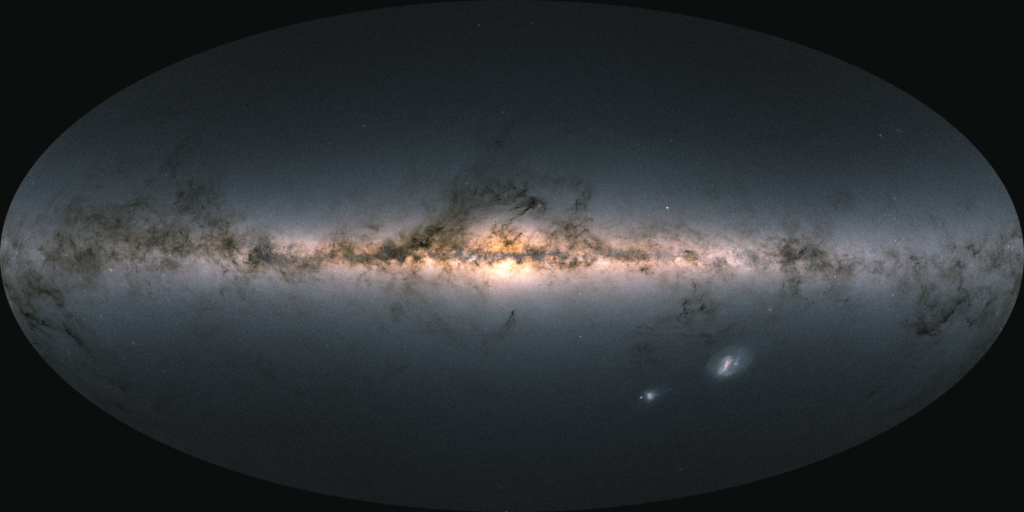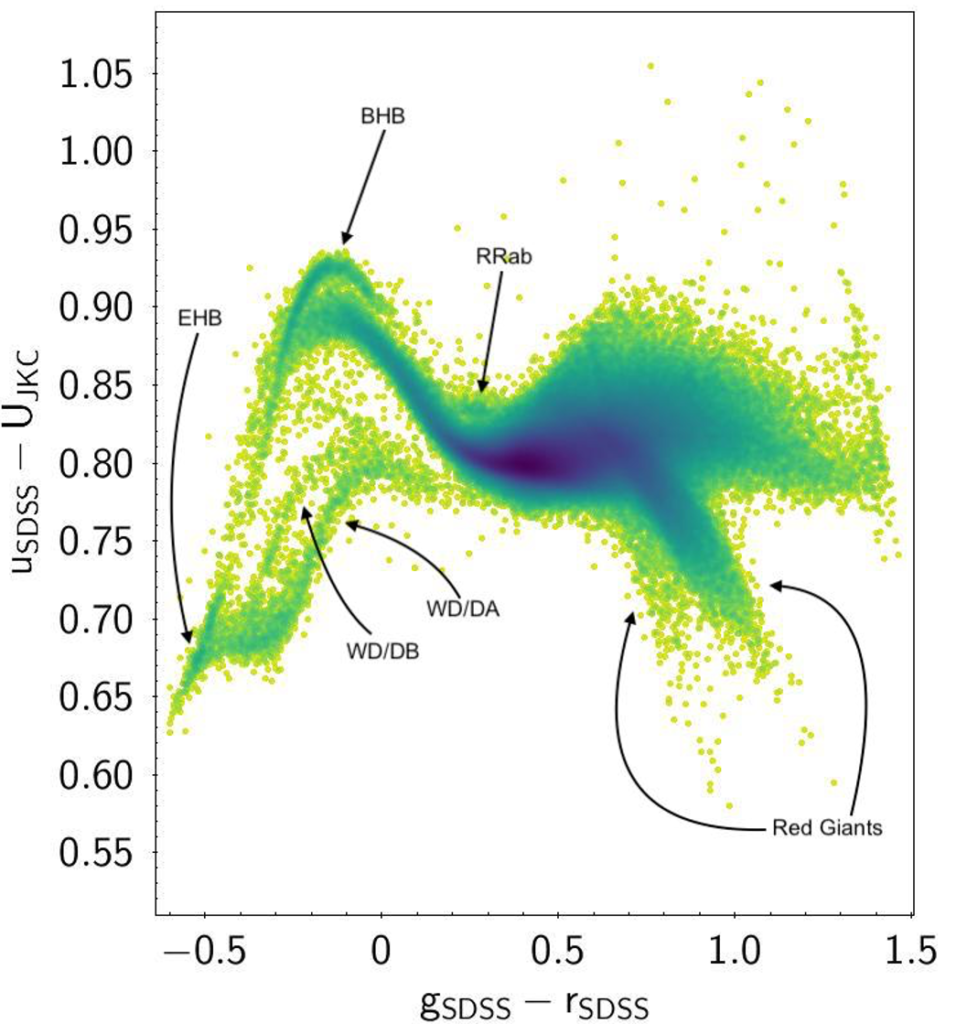 Sky map showing the total brightness and colour of stars observed by Gaia and released as part of Gaia’s Early Data Release 3 (Gaia EDR3). Published here. Credits: ESA/Gaia/DPAC – CC BY-SA 3.0 IGO.
Sky map showing the total brightness and colour of stars observed by Gaia and released as part of Gaia’s Early Data Release 3 (Gaia EDR3). Published here. Credits: ESA/Gaia/DPAC – CC BY-SA 3.0 IGO.
Gaia is a cornerstone mission of the ESA Space Program, successfully launched on December 19, 2013. The Gaia satellite will perform an all-sky survey to obtain parallaxes and proper motions to µas precision for about 109 objects and astrophysical parameters (Teff, log g, E(B-V), metallicity etc.) for stars down to a limiting magnitude of V ∼ 20, plus 2-30 km/s (depending on spectral type) accuracy radial velocity for several millions of stars down to V ≤ 17.
Such an observational effort has been compared to the mapping of the human genome for the amount of collected data and for the impact that it will have on all the branches of astronomy and astrophysics. The expected end-of-mission astrometric accuracies are ∼ 7 µas at V < 12, ∼ 20 µas at V = 15 and ∼ 300 µas at V = 20, outperforming any existing measure, including the HIPPARCOS dataset (∼ 1000 µas at V = 9 and ∼ 3000 µas at V < 12 ; see Perryman et al. 1997, ESA-SP 1200).
This exquisite precision will allow a full and detailed reconstruction of the 3D spatial structure and 3D velocity field of the Milky Way galaxy within ∼ 10 kpc from the Sun. This will provide answers to long-standing questions about the origin and history of our Galaxy, from a quantitative census of its stellar populations, to a detailed characterization of its substructures (as, for instance, tidal streams in the Halo, see Ibata & Gibson, 2007, Sci. Am., 296, 40), to the distribution of dark matter. The accurate 3D motion of much more distant Galactic satellites (as globular clusters and the Magellanic Clouds) will be also obtained by averaging the proper motions of many thousands of member stars: this will provide an unprecedented leverage to constrain the mass distribution of the Galaxy and/or non-standard theories of gravitation (see Milgrom 2008, arXiv0801.3133).
Gaia will determine direct geometric distances to essentially any kind of standard candle currently used for distance determination, setting the whole cosmological distance scale on extremely firm bases. For example, the distance to the 100 nearest Cepheids will be measured with an accuracy σπ/π < 0.5%, the distances to thousands of RR Lyrae and Miras will be known to 1% ≤ σπ/π ≤ 10%, the distance to many globular clusters will be derived with 1% accuracy or better.
The Gaia scanning law implies that a given spot of the sky will be observed from ≥ 40 to ≤ 250 times during the mission (with an average of 80 observations per field, see Carrasco et al. 2006, Gaia-C5-TN-UB-JMC-001-2; 2007, Gaia-C5-TN-UB-JMC-002-1): therefore, time series to monitor any kind of known or unknown variable sources will come as a by-product, as well as a huge number of alerts on supernovae, novae, etc.
Additional products include, for example, detection and orbital classification of thousands of extra-Solar planetary systems, a comprehensive survey of some 106 minor bodies in our Solar System, discovering and monitoring of some 500 000 distant quasars, detailed orbit characterization for millions of binary systems (and hence determination of millions of stellar masses), very stringent tests on the stellar evolution theory will be possible, over the whole HR diagram.
For a more complete review of Gaia science cases see Mignard (2005, ESA SP-576, 5), Perryman et al. (2001, A&A, 369, 339) and http://www.cosmos.esa.int/web/gaia
The 2nd Data Release of Gaia data happened on April 25, 2018.
The Early 3rd Release of Gaia data happened on December 3, 2020
The 3rd Data Release of Gaia data happened on June 13, 2022
A Gaia Focused Product release is planned for October 10, 2023
The 4th Data Release of Gaia is planned for 2025
Exploiting the full potentiality of Gaia: the Data Processing and Analysis Consortium
As challenging as it is, the processing and analysis of the huge data-flow incoming from Gaia is the subject of thorough study and preparatory work by the Data Processing and Analysis Consortium (DPAC), in charge of all aspects of the data reduction and calibration work. The European scientific community is deeply involved in the DPAC effort: the consortium comprises 385 scientists from 24 European institutes. DPAC is organized at a high level in Coordination Units (CU, dealing with a wide branch of the pipeline, as for instance “Photometry”, “Astrometry”, “System Architecture”, or “Astrophysical parameters” among others) which, in turn, are subdivided into Development Units that actually develop specific parts of the pipeline.
People involved @ OAS Bo (as of June 2023): Carla Cacciari (manager of calibration model unit, CU5-DU14); Gisella Clementini (manager of variable stars supplementary observations CU7-DU32 and of the workpackage Cepheids&RRLyrae stars of CU7-DU20), Michele Bellazzini, Angela Bragaglia, Alessia Garofalo, Davide Massari, Paolo Montegriffo, Tatiana Muraveva.
P. Montegriffo & M. Bellazzini lead the team of the DR3 performance verification paper on Synthetic Photometry.

Colour-colour diagram generated by combining the Johnson-Kron-Cousins U magnitude, and magnitudes in the SDSS system (u, g, r) as measured from the Gaia XP spectra using synthetic photometry. Some loci of the stellar evolutions are marked (Red Giants; BHB: Blue Horizontal Branch; EHB: Extreme HB; RRab: RR Lyrae stars; WD/DA, WD/DB: White Dwarfs of type DA and DB). Image credits: ESA/Gaia/DPAC – CC BY-SA 3.0 IGO. Acknowledgements: M. Bellazzini.
